Aqui no WPBeginner, orientamos milhões de usuários sobre como otimizar seus sites para pesquisa e aumentar o tráfego orgânico. Descobrimos que um aspecto do SEO que os iniciantes geralmente ignoram é o arquivo robots.txt, que ajuda os mecanismos de pesquisa a descobrir, rastrear e indexar seu site.
Esse arquivo de texto simples funciona como um conjunto de instruções, orientando os bots dos mecanismos de pesquisa sobre quais partes do seu site devem ser acessadas e quais devem ser deixadas de lado.
Ao otimizar seu arquivo robots.txt, você pode garantir que os mecanismos de pesquisa se concentrem no rastreamento e na indexação do conteúdo mais importante, evitando que eles desperdicem recursos em áreas menos importantes do seu site.
Este artigo mostrará algumas dicas sobre como criar um arquivo robots.txt perfeitamente otimizado para seu site WordPress, maximizando seu potencial de SEO.
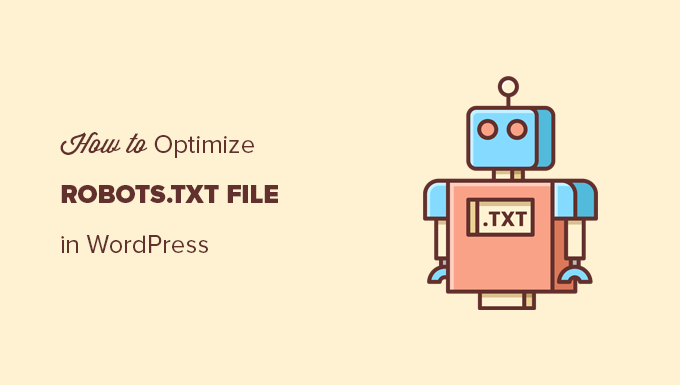
O que é um arquivo Robots.txt?
O Robots.txt é um arquivo de texto que os proprietários de sites podem criar para informar aos bots dos mecanismos de pesquisa como rastrear e indexar as páginas de seus sites.
Normalmente, ele é armazenado no diretório raiz (também conhecido como pasta principal) de seu site. O formato básico de um arquivo robots.txt é o seguinte:
1 2 3 4 5 6 7 | User-agent: [user-agent name]Disallow: [URL string not to be crawled] User-agent: [user-agent name]Allow: [URL string to be crawled] Sitemap: [URL of your XML Sitemap] |
Você pode ter várias linhas de instruções para permitir ou não URLs específicos e adicionar vários sitemaps. Se você não proibir um URL, os bots dos mecanismos de busca presumirão que têm permissão para rastreá-lo.
Veja a seguir um exemplo de arquivo robots.txt:
1 2 3 4 5 6 | User-Agent: *Allow: /wp-content/uploads/Disallow: /wp-content/plugins/Disallow: /wp-admin/Sitemap: https://example.com/sitemap_index.xml |
No exemplo do robots.txt acima, permitimos que os mecanismos de pesquisa rastreiem e indexem arquivos na pasta de uploads do WordPress.
Depois disso, não permitimos que os bots de busca rastreassem e indexassem plug-ins e pastas de administração do WordPress.
Por fim, fornecemos o URL do nosso sitemap XML.
Você precisa de um arquivo Robots.txt para seu site WordPress?
Se você não tiver um arquivo robots.txt, os mecanismos de pesquisa ainda rastrearão e indexarão seu site. No entanto, você não poderá informar a eles quais páginas ou pastas não devem ser rastreadas.
Isso não terá muito impacto quando você começar um blog pela primeira vez e não tiver muito conteúdo.
No entanto, à medida que seu site crescer e você adicionar mais conteúdo, provavelmente desejará ter um controle melhor sobre como o site é rastreado e indexado.
Aqui está o motivo.
Os bots de busca têm uma cota de rastreamento para cada site.
Isso significa que eles rastreiam um determinado número de páginas durante uma sessão de rastreamento. Se eles esgotarem o orçamento de rastreamento antes de terminar de rastrear todas as páginas do seu site, eles voltarão e retomarão o rastreamento na próxima sessão.
Isso pode reduzir a taxa de indexação de seu site.
Você pode corrigir isso impedindo que os bots de busca tentem rastrear páginas desnecessárias, como as páginas de administração do WordPress, os arquivos de plug-in e a pasta de temas.
Ao não permitir páginas desnecessárias, você economiza sua cota de rastreamento. Isso ajuda os mecanismos de pesquisa a rastrear ainda mais páginas em seu site e a indexá-las o mais rápido possível.
Outro bom motivo para usar um arquivo robots.txt é quando você deseja impedir que os mecanismos de pesquisa indexem um post ou uma página do seu site.
Essa não é a maneira mais segura de ocultar o conteúdo do público em geral, mas o ajudará a impedir que o conteúdo apareça nos resultados de pesquisa.
Qual é a aparência de um arquivo Robots.txt ideal?
Muitos blogs populares usam um arquivo robots.txt muito simples. Seu conteúdo pode variar de acordo com as necessidades do site específico:
1 2 3 4 5 | User-agent: *Disallow:Sitemap: https://www.example.com/post-sitemap.xmlSitemap: https://www.example.com/page-sitemap.xml |
Esse arquivo robots.txt permite que todos os robôs indexem todo o conteúdo e fornece a eles um link para os sitemaps XML do site.
Para sites WordPress, recomendamos as seguintes regras no arquivo robots.txt:
1 2 3 4 5 6 7 8 | User-Agent: *Allow: /wp-content/uploads/Disallow: /wp-admin/Disallow: /readme.htmlDisallow: /refer/Sitemap: https://www.example.com/post-sitemap.xmlSitemap: https://www.example.com/page-sitemap.xml |
Isso diz aos bots de busca para indexar todas as imagens e arquivos do WordPress. Isso impede que os bots de busca indexem a área de administração do WordPress, o arquivo leia-me e os links de afiliados camuflados.
Ao adicionar sitemaps ao arquivo robots.txt, você facilita a localização de todas as páginas do seu site pelos bots do Google.
Agora que você já sabe como é um arquivo robots.txt ideal, vamos dar uma olhada em como criar um arquivo robots.txt no WordPress.
Como criar um arquivo Robots.txt no WordPress
Há duas maneiras de criar um arquivo robots.txt no WordPress. Você pode escolher o método que funciona melhor para você.
Método 1: Edição do arquivo Robots.txt usando o All in One SEO
OAll in One SEO, também conhecido como AIOSEO, é o melhor plugin de SEO para WordPress do mercado, usado por mais de 3 milhões de sites. É fácil de usar e vem com um gerador de arquivos robots.txt.
Para saber mais, consulte nossa análise detalhada do AIOSEO.
Se você ainda não tiver o plug-in AIOSEO instalado, consulte nosso guia passo a passo sobre como instalar um plug-in do WordPress.
Observação: uma versão gratuita do AIOSEO também está disponível e tem esse recurso.
Depois que o plug-in estiver instalado e ativado, você poderá usá-lo para criar e editar o arquivo robots.txt diretamente da área de administração do WordPress.
Basta acessar All in One SEO ” Ferramentas para editar seu arquivo robots.txt.
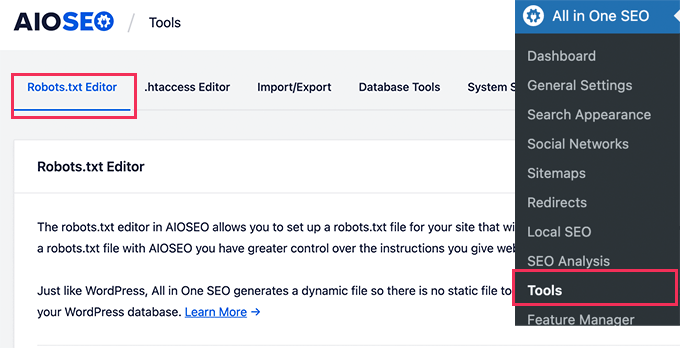
Primeiro, você precisará ativar a opção de edição clicando na opção “Enable Custom Robots.txt” (Ativar Robots.txt personalizado) na cor azul.
Com essa opção ativada, você pode criar um arquivo robots.txt personalizado no WordPress.

O All in One SEO mostrará o arquivo robots.txt existente na seção “Robots.txt Preview” (Visualização do arquivo robots.txt) na parte inferior da tela.
Essa versão mostrará as regras padrão que foram adicionadas pelo WordPress.
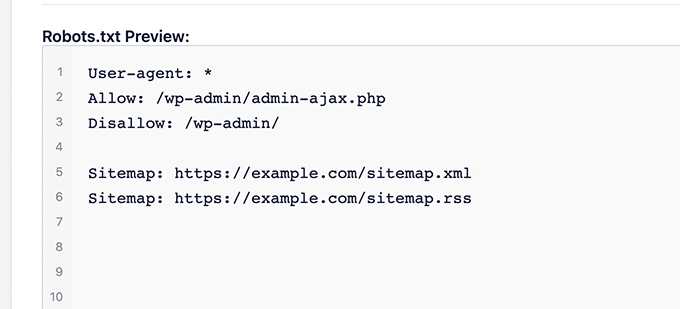
Essas regras padrão informam aos mecanismos de pesquisa que não devem rastrear seus arquivos principais do WordPress, permitem que os bots indexem todo o conteúdo e fornecem a eles um link para os sitemaps XML do seu site.
Agora, você pode adicionar suas próprias regras personalizadas para aprimorar o robots.txt para SEO.
Para adicionar uma regra, insira um agente de usuário no campo “User Agent”. O uso de um * aplicará a regra a todos os agentes de usuário.
Em seguida, selecione se deseja “Permitir” ou “Não permitir” o rastreamento dos mecanismos de pesquisa.
Em seguida, digite o nome do arquivo ou o caminho do diretório no campo “Directory Path” (Caminho do diretório).
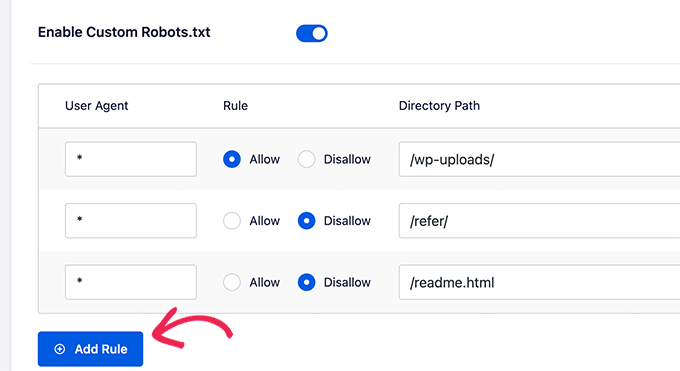
A regra será aplicada automaticamente ao seu robots.txt. Para adicionar outra regra, basta clicar no botão “Add Rule”.
Recomendamos adicionar regras até que você crie o formato ideal de robots.txt que compartilhamos acima.
Suas regras personalizadas terão a seguinte aparência.
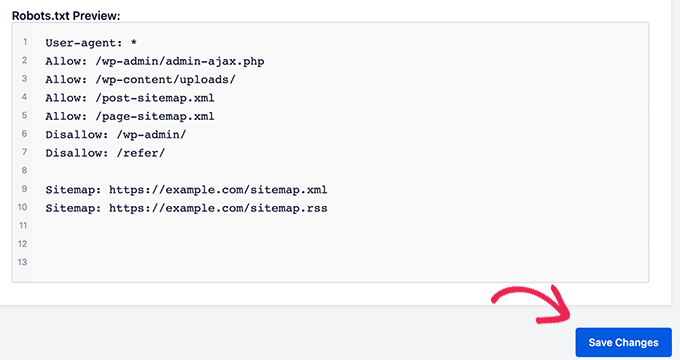
Quando terminar, não se esqueça de clicar no botão “Save Changes” (Salvar alterações) para armazenar suas alterações.
Método 2: Edição do arquivo Robots.txt usando o WPCode
O WPCode é um poderoso plug-in de snippets de código que permite adicionar códigos personalizados ao seu site de forma fácil e segura.
Ele também inclui um recurso útil que permite que você edite rapidamente o arquivo robots.txt.
Observação: Há também um plug-in gratuito do WPCode, mas ele não inclui o recurso de editor de arquivos.
A primeira coisa que você precisa fazer é instalar o plug-in WPCode. Para obter instruções passo a passo, consulte nosso guia para iniciantes sobre como instalar um plug-in do WordPress.
Na ativação, você precisa navegar até a página WPCode ” File Editor. Uma vez lá, basta clicar na guia “robots.txt” para editar o arquivo.
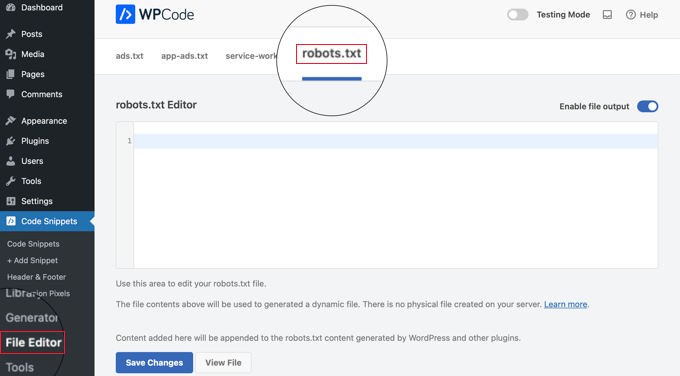
Agora, você pode colar ou digitar o conteúdo do arquivo robots.txt.
Quando terminar, certifique-se de clicar no botão “Save Changes” (Salvar alterações) na parte inferior da página para armazenar as configurações.
Método 3: Edição manual do arquivo Robots.txt usando FTP
Para esse método, você precisará usar um cliente FTP para editar o arquivo robots.txt. Como alternativa, você pode usar o gerenciador de arquivos fornecido pela sua hospedagem do WordPress.
Basta conectar-se aos arquivos do seu site WordPress usando um cliente FTP.
Uma vez lá dentro, você poderá ver o arquivo robots.txt na pasta raiz do seu site.
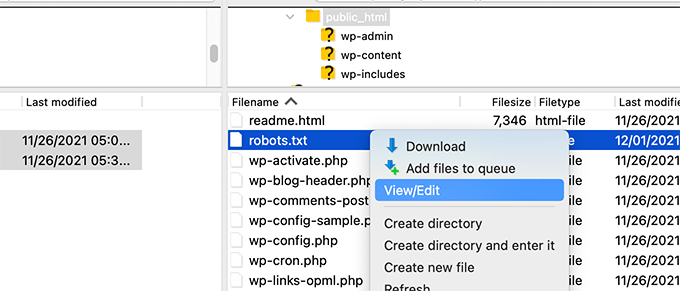
Se você não encontrar um, provavelmente não tem um arquivo robots.txt.
Nesse caso, você pode ir em frente e criar um.
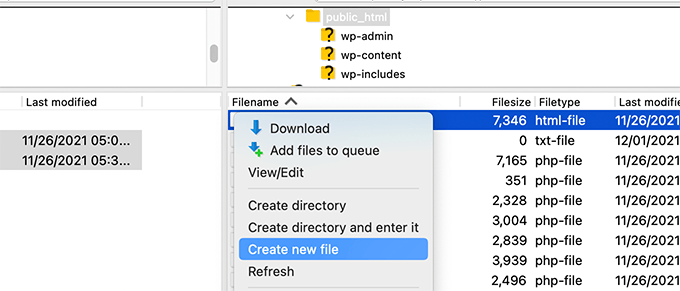
O Robots.txt é um arquivo de texto simples, o que significa que você pode baixá-lo para o seu computador e editá-lo usando qualquer editor de texto simples, como o Notepad ou o TextEdit.
Depois de salvar as alterações, você pode fazer upload do arquivo robots.txt de volta para a pasta raiz do seu site.
Como testar seu arquivo Robots.txt
Depois de criar o arquivo robots.txt, é sempre uma boa ideia testá-lo usando uma ferramenta de teste de robots.txt.
Há muitas ferramentas de teste de robots.txt no mercado, mas recomendamos usar a que está no Google Search Console.
Primeiro, você precisará ter seu website vinculado ao Google Search Console. Se ainda não tiver feito isso, consulte nosso guia sobre como adicionar seu site WordPress ao Google Search Console.
Em seguida, você pode usar a ferramenta de teste de robôs do Google Search Console.
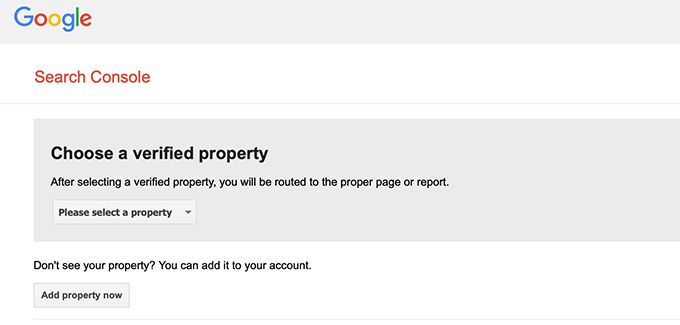
Basta selecionar sua propriedade na lista suspensa.
A ferramenta buscará automaticamente o arquivo robots.txt do seu site e destacará os erros e avisos, caso encontre algum.
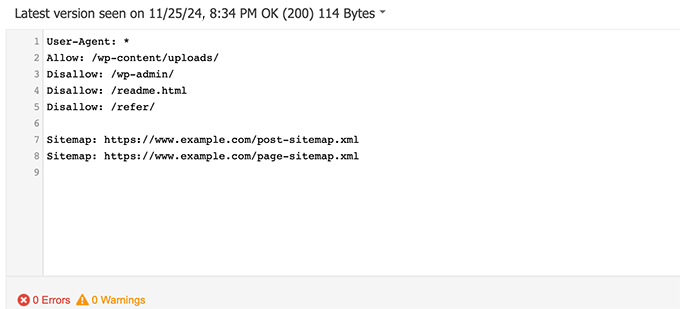
Considerações finais
O objetivo de otimizar seu arquivo robots.txt é impedir que os mecanismos de pesquisa rastreiem páginas que não estejam disponíveis publicamente. Por exemplo, páginas em sua pasta wp-plugins ou páginas em sua pasta de administração do WordPress.
Um mito comum entre os especialistas em SEO é que o bloqueio de categorias, tags e páginas de arquivo do WordPress melhorará a taxa de rastreamento e resultará em indexação mais rápida e classificações mais altas.
Isso não é verdade. Isso também é contra as diretrizes para webmasters do Google.
Recomendamos que você siga o formato robots.txt acima para criar um arquivo robots.txt para o seu site.
Guias especializados sobre o uso do Robots.txt no WordPress
Agora que você sabe como otimizar seu arquivo robots.txt, talvez queira ver outros artigos relacionados ao uso do robots.txt no WordPress.
- Glossário: Robots.txt
- Como ocultar uma página do WordPress do Google
- Como impedir que os mecanismos de pesquisa rastreiem um site WordPress
- Como excluir permanentemente um site WordPress da Internet
- Como ocultar facilmente (Noindex) arquivos PDF no WordPress
- Como corrigir o erro “O Googlebot não pode acessar arquivos CSS e JS” no WordPress
- Como configurar corretamente o All in One SEO para WordPress (guia definitivo)
Esperamos que este artigo tenha ajudado você a aprender como otimizar seu arquivo robots.txt do WordPress para SEO. Talvez você também queira ver nosso guia definitivo de SEO para WordPress e nossas escolhas de especialistas para as melhores ferramentas de SEO para WordPress para aumentar seu site.
Se você gostou deste artigo, inscreva-se em nosso canal do YouTube para receber tutoriais em vídeo sobre o WordPress. Você também pode nos encontrar no Twitter e no Facebook.





Moinuddin Waheed
Thanks for this informative post about robots.txt file.
I didn’t know that websites should maintain this file in order to have a control over Google bots that how should they crawl over our pages and posts.
for beginner websites just starting out, is there a need to have robots.txt file or is there a way like plugin which can a make a robots.txt file for our website?
WPBeginner Support
Most SEO plugins help with setting up the robots.txt for a new site to prevent bots from scrolling sections they shouuldn’t.
Admin
Jiří Vaněk
Thanks to this article, I checked the robots.txt file and added URL addresses with sitemaps. At the same time, I had other problematic lines there, which were revealed by the validator. I wasn’t familiar with sitemaps in robots.txt until now. Thanks.
WPBeginner Support
You’re welcome, glad our guide could help!
Admin
Stéphane
Hi,
Thanks for that post, it becomes clearer how to use the robots.txt file. On most websites that you find while looking for some advice regarding the robots.txt file, you can see that the following folders are explicitly excluded from crawling (for WordPress):
Disallow: /wp-content/plugins
Disallow: /wp-content/cache
Disallow: /wp-content/themes
I don’t really understand the reasons to exclude those folders (is there one actually?). What would be your take regarding that matter?
WPBeginner Support
It is mainly to prevent anything in those folders from showing as a result when a user searches for your site. As that is not your content it is not something most people would want to appear for the site’s results.
Admin
zaid haris
Disallow: /wp-admin/
Allow: /wp-admin/admin-ajax.php
GSC show the coverage error for “Disallow: /wp-admin/” Is this wrong?
WPBeginner Support
For most sites, you do not want anything from your wp-admin to appear as a search result so it is fine and expected to receive the coverage area when you deny Google the ability to scan your wp-admin.
Admin
Hansini
I am creating my robots.txt manually as you instructed for my WordPress site.
I have one doubt. when I write User-Agent: * won’t it allow another spamming robot to access my site?
Should I write User-Agent: * or User-Agent: Googlebot.?
WPBeginner Support
The User-Agent line is setting the rules that all robots should follow on your site, if you specify a specific bot on that line it would be setting rules for that specific bot and none of the others.
Admin
Nishant
What should we write to make google index my post?
WPBeginner Support
For having your site listed, you would want to take a look at our article below:
https://www.wpbeginner.com/beginners-guide/how-do-i-get-my-wordpress-site-listed-on-google-beginners-guide/
Admin
Sanjeev Pandey
should we also disallow /wp-content/themes/ ?
It is appearing in the search result when I run the command site:abcdef.com in google search
WPBeginner Support
You would not want to worry about blocking your themes folder and as you write SEO-friendly content you should no longer see the themes as a search result.
Admin
Salem
HI, What’s means ” Disallow: /readme.html & Disallow: /refer/ ” ?
WPBeginner Support
That means you’re telling search engines to not look at any referral links or the readme.html file.
Admin
sean
Hi, what are the pros and cons of blocking wp-content/uploads
Thank you
WPBeginner Support
If you block your uploads folder then search engines would not normally crawl your uploaded content like images.
Admin
Piyush
thanks for solve my problem
WPBeginner Support
You’re welcome
Admin
Ravi kumar
Sir i m very confused about robot.txt many time i submitted site map in blogger but the after 3,4 days coming the same issue what is the exactly robot.txt.. & how submit that please guide me
WPBeginner Support
It would depend on your specific issue, you may want to take a look at our page below:
https://www.wpbeginner.com/glossary/robots-txt/
Admin
Prem
If I no index a url or page using robots.txt file, does google shows any error in search console?
WPBeginner Support
No, Google will not list the page but if the page is listed it will not show an error.
Admin
Bharat
Hi
I have a question
i receive google search console coverage issue warning for blocked by robots.txt
/wp-admin/widgets.php
My question is, can i allow for wp-admin/widgets.php to robots.txt and this is safe?
WPBeginner Support
IF you wanted to you can but that is not a file that Google needs to crawl.
Admin
Anthony
Hi there, I’m wondering if you should allow: /wp-admin/admin-ajax.php?
WPBeginner Support
Normally, yes you should.
Admin
Jaira
May I know why you should allow /wp-admin/admin-ajax.php?
WPBeginner Support
It is used by different themes and plugins to appear correctly for search engines.
Amila
Hello! I really like this article and as I’m a beginner with all this crawling stuff I would like to ask something in this regard. Recently, Google has crawled and indexed one of my websites on a really terrible way, showing the pages in search results which are deleted from the website. The website didn’t have discouraged search engine from indexing in the settings of WordPress at the beginning, but it did later after Google showed even 3 more pages in the search results (those pages also doesn’t exist) and I really don’t understand how it could happen with “discourage search engine from indexing” option on. So, can the Yoast method be helpful and make a solution for my website to Google index my website on the appropriate way this time? Thanks in advance!
WPBeginner Support
The Yoast plugin should be able to assist in ensuring the pages you have are indexed properly, there is a chance before you discouraged search engines from crawling your site your page was cached.
Admin
Amila
Well yes and from all pages, it cached the once who doesn’t exist anymore. Anyway, as the current page is on “discourage” setting on, is it better to keep it like that for now or to uncheck the box and leave the Google to crawl and index it again with Yoast help? Thanks! With your articles, everything became easier!
WPBeginner Support
You would want to have Google recrawl your site once it is set up how you want.
Pradhuman Kumar
Hi I loved the article, very precise and perfect.
Just a small suggestion kindly update the image ROBOTS.txt tester, as Google Console is changed and it would be awesome if you add the link to check the robots.txt from Google.
WPBeginner Support
Thank you for the feedback, we’ll be sure to look into updating the article as soon as we are able.
Admin
Kamaljeet Singh
My blog’s robots.txt file was:
User-Agent: *
crawl-delay: 10
After reading this post, I have changed it into your recommended robots.txt file. Is that okay that I removed crawl-delay
WPBeginner Support
It should be fine, crawl-delay tells search engines to slow down how quickly to crawl your site.
Admin
reena
Very nicely described about robot.text, i am very happy
u r very good writer
WPBeginner Support
Thank you, glad you liked our article
Admin
JJ
What is Disallow: /refer/ page ? I get a 404, is this a hidden wp file?
Editorial Staff
We use /refer/ to redirect to various affiliate links on our website. We don’t want those to be indexed since they’re just redirects and not actual content.
Admin
Sagar Arakh
Thank you for sharing. This was really helpful for me to understand robots.txt
I have updated my robots.txt to the ideal one you suggested. i will wait for the results now
WPBeginner Support
You’re welcome, glad you’re willing to use our recommendations
Admin
Akash Gogoi
Very helpful article. Thank you very much.
WPBeginner Support
Glad our article was helpful
Admin
Zingylancer
Thanks for share this useful information about us.
WPBeginner Support
Glad we could share this information about the robots.txt file
Admin
Jasper
thanks for update information for me. Your article was good for Robot txt. file. It gave me a piece of new information. thanks and keep me updating with new ideas.
WPBeginner Support
Glad our guide was helpful
Admin
Imran
Thanks , I added robots.txt in WordPress .Very good article
WPBeginner Support
Thank you, glad our article was helpful
Admin
Steve
Thanks for this – how does it work on a WP Multisite thou?
WPBeginner Support
For a multisite, you would need to have a robots.txt file in the root folder of each site.
Admin
Pacifique Ndanyuzwe
My wordpress site is new and my robot.txt by default is
user-agent: *
Disallow: /wp-admin/
Allow: /wp-admin/admin-ajax.php
I want google to crawl and index my content. Is that robot.txt okay?
WPBeginner Support
You can certainly use that if you wanted
Admin
Ritesh Seth
Great Airticle…
I was confused from so many days about Robots.txt file and Disallow links. Have copied the tags for robots file. Hope this will solve the issue of my Site
WPBeginner Support
We hope our article will help as well
Admin
Kurt
The files in the screenshots of your home folder are actually located under the public_html folder under my home folder.
I did not have a /refer folder under my public_html folder.
I did not have post or page xml files anywhere on my WP account.
I did include an entry in the robots.txt file I created to disallow crawling my sandbox site. I’m not sure that’s necessary since I’ve already selected the option in WP telling crawlers not to crawl my sandbox site, but I don’t think it will hurt to have the entry.
WPBeginner Support
Some hosts do rename public_html to home which is why you see it there. You would want to ensure Yoast is active for the XML files to be available. The method in this article is an additional precaution to help with preventing crawling your site
Admin
Ahmed
Great article
WPBeginner Support
Thank you
Admin
ASHOK KUMAR JADON
Hello, such a nice article you solve my problem. So Thank You so much
WPBeginner Support
Glad our article could help
Admin
Elyn Ashton
User-agent: *
Disallow: /wp-admin/
Allow: /wp-admin/admin-ajax.php <– This is my robot.txt code but im confuse why my /wp-admin is index? How to no index it?
WPBeginner Support
If it was indexed previously you may need to give time for the search engine’s cache to clear
Admin
Ashish kumar
This website really inspire me to start a blog .Thank you lost of tema.this website each and every article have rich of information and explanation.when i have some problem at first i visit this blog . Thank You
WPBeginner Support
Glad our articles can be helpful
Admin
Anna
I am trying to optimise robots for my website using Yoast. However Tools in Yoast does not have the option for ‘File Editor’.
There are just two options
(i) Import and Export
(ii) Bulk editor
May you please advise how this can be addressed. Could it be that I am on a free edition of Yoast?
WPBeginner Support
The free version of Yoast still has the option, your installation may be disallowing file editing in which case you would likely need to use the FTP method.
Admin
Emmanuel Husseni
I really find this article helpful because I really don’t know much on how robot.txt works but now I do.
pls what I don’t understand is how do I find the best format of robot.txt to use on my site (I mean one that works generally)?
I noticed lots of big blogs I check ranking high on search engine uses different robot.txt format..
I’ll be clad to see a reply from you or just anyone that can help
Editorial Staff
Having a sitemap and allowing the areas that need to be allowed is the most important part. The disallow part will vary based on each site. We shared a sample in our blog post, and that should be good for most WordPress sites.
Admin
WPBeginner Support
Hey Emmanuel,
Please see the section regarding the ideal robots.txt file. It depends on your own requirements. Most bloggers exclude WordPress admin and plugin folders from the crawl.
Admin
Emmanuel Husseni
Thank you so much.
now I understand. I guess I’ll start with the general format for now.
jack
Well written article, I recommend the users to do sitemap before creating and enabling their ROBOTS text it will help your site to crawl faster and indexed easily.
Jack
Connie S Owens
I would like to stop the search engines from indexing my archives during their crawl.
Emmanuel Nonye
Thanks alot this article it was really helpful
Cherisa
I keep getting the error message below on google webmaster. I am basically stuck. A few things that were not clear to me on this tutorial is where do I find my site’s root files, how do you determine if you already have a “robots.txt” and how do you edit it?
WPBeginner Support
Hi Cherisa,
Your site’s root folder is the one that contains folders like wp-admin, wp-includes, wp-content, etc. It also contains files like wp-config.php, wp-cron.php, wp-blogheader.php, etc.
If you cannot see a robots.txt file in this folder, then you don’t have one. You can go a head and create a new one.
Admin
Cherisa
Thank you for your response. I have looked everywhere and can’t seem to locate these root files as you describe. Is there a path directory I can take that leads to this folder. Like it is under Settings, etc?
Devender
I had a decent web traffic to my website. Suddenly dropped to zero in the month of May. Till now I have been facing the issue. Please help me to recover my website.
Haris Aslam
Hello There Thank you For This Information, But I Have A Question
That I Just Create The Sitemap.xml and Robots.txt File, & Its Crawling well. But How Can I Create “Product-Sitemap.xml”
There is all list of product in sitemap.xml file. Do I Have To Create Product-sitemap.xml separately?
and submit to google or bing again ?
Can You please Help me out…
Thank You
Mahadi Hassan
I have a problem on robots.txt file setting. Only one robots.txt is showing for all websites. Please help me to show separate robots.txt file of all websites. I have all separate robots.txt file of all individual website. But only one robots.txt file is showing in browser for all websites.
Debu Majumdar
Please explain why did you include
Disallow: /refer/
in the beginner Robots.txt example? I do not understand the implications of this line. Is this important for the beginner? You have explained the other two Disallowed ones.
Thanks.
WPBeginner Support
Hi Debu,
This example was from WPBeginner’s robots.txt file. At WPBeginner we use ThirstyAffiliates to manage affiliate links and cloak URLs. Those URLs have /refer/ in them, that’s why we block them in our robots.txt file.
Admin
Evaristo
How can I put all tags/mydomain.Com in nofollow? In robots.txt to concentrate the link Juice? Thanks.
harsh kumar
hey,,i am getting error in yoast seo regarding site map..once i click on fix it ,,,it’s coming again..my site html is not loading properly
Tom
I’ve just been reviewing my Google Webmaster Tools account and using the Search Console, I’ve found the following:
Page partially loaded
Not all page resources could be loaded. This can affect how Google sees and understands your page. Fix availability problems for any resources that can affect how Google understands your page.
This is because all CSS stylesheets associated with Plugins are disallowed by the default robots.txt.
I understand good reasons why I shouldn’t just make this allowable, but what would be an alternative as I would suspect the Google algorithms are marking down the site for not seeing these.
Suren
Hi,
Whenever, I search my site on the google this text appears below the link: “A description for this result is not available because of this site’s robots.txt”
How, can i solve this issue?
Regards
WPBeginner Support
Hi Suren,
Seems like someone accidentally changed your site’s privacy settings. Go to Settings » Reading page and scroll down to ‘Search engine visibility’ section. Make sure that the box next to is unchecked.
Admin
Divyesh
Hello
As i seen in webmaster tool, i got robot.txt file like below :
User-agent: *
Disallow: /wp-admin/
Allow: /wp-admin/admin-ajax.php
let me know is that okey ? or should i use any other ?
John Cester
I want to know, does it a good idea to block (disallow) “/wp-content/plugins/” in robots.tx? Every time i remove a plugin it shows 404 error in some pages of that plugin.
Himanshu singh
I loved this explanation. As a beginner I was very confused about robot.txt file and its uses. But now I know what is its purpose.
rahul
in some robot.txt file index.php has been disallowed. Can you explain why ? is it a good practice.